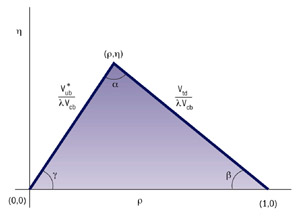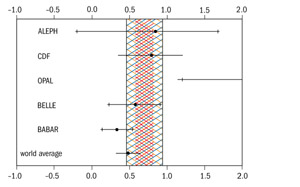New results from the “B factories” could help to explain why a universe made of matter emerged from a Big Bang that created equal amounts of matter and antimatter.

As reported in this month’s News, two major experiments have provided the first observation of the delicate CP violation effect in a totally new domain: the decay of B mesons, which contain the fifth (“b”) quark. The obscure phenomenon that physicists call CP violation could have been the mould that formed a universe of matter from the Big Bang’s equal mixture of matter and antimatter. After the shock discovery in 1956 that nuclear beta decay is spectacularly left-right asymmetric (P-violating), the proposition of CP (charge/parity) symmetry, with left-handed particles behaving in the same way as right-handed antiparticles, seemed a natural theoretical handhold for physicists to grasp. However, further experiments carried out in 1964 found that CP symmetry was also flawed. To reach an understanding of why CP violation happens, physicists must first measure exactly how it happens.
The B-route

Until recently the only particle that showed CP violation was the neutral kaon, where CP violation was originally discovered in 1964. However, according to the conventional wisdom of today’s Standard Model (SM) of particle physics, CP violation should also be observed in the decays of B particles. Only recently have experiments been able to look into this further. CP violation has its own language. In this CP-speak, the quark transitions responsible for CP violation are conventionally described by a 3 x 3 matrix – the Cabibbo/ Kobayashi/ Maskawa (CKM) matrix – the rows and columns of which correspond to transitions involving the six types of quark. For the B meson system, the relevant parts of this matrix are conveniently represented by a Unitarity Triangle (figure 1) the angles of which can be measured via CP violation effects. One of these angles, ß, or rather sin2 ß, is now being probed.
A first shot at this measurement was taken by the Opal and Aleph collaborations at CERN’s LEP electron-positron collider. In these experiments the decays of Z particles into b quark-antiquark pairs were harnessed to “tag” B particles, with the decay of neutral B mesons and their antiparticles monitored via their disintegration into J/psi and a short-lived kaon.
LEP results for sin2 ß were severely limited by statistics and did not quantitatively test SM predictions. Prior to the advent of the new B-factories (PEP-II at SLAC, Stanford, and KEKB at KEK, Japan), the CDF collaboration at Fermilab’s Tevatron proton antiproton collider reported the first real measurement – sin2 ß = 0.79 + 0.41 – 0.44 – disfavouring negative values for sin2 ß, which are possible in unorthodox scenarios.
First results from the B-factories were reported last summer at the international high-energy conference in Osaka, Japan, and caused quite a stir. In particular, the value reported by the BaBar collaboration at PEP-II – sin2 ß = 0.12 ± 0.37 ± 0.09 – was significantly lower than the SM predictions but was not conclusive due to limited statistics.
In February the Belle (KEKB) and BaBar collaborations announced their updated results. The BaBar measurement now makes use of 23 million upsilon(4S) decays into B pairs, while the Belle measurement so far corresponds to approximately half of that number. The principal decay modes used are B decays into J/psi and a short-lived kaon; into J/psi and a long-lived kaon; and into psi(2S) and a short-lived kaon. However, a small number of other modes are also reported.
Their measured values sin2 ß = 0.58 + 0.32 – 0.34 + 0.09 – 0.1 (Belle) and 0.34 ± 0.20 ± 0.05 (BaBar) are shown together with the earlier results in figure 2. Compared with last summer, the errors from BaBar and Belle have come down considerably, but the reported values of sin2 ß are still consistent with no CP violation within two standard deviations. However, the combined data of all five experiments yields a world average of 0.49 ± 0.16, constituting a measurement at slightly more than three standard deviations. It thus establishes CP violation for the first time in any system other than kaons.
Unitarity triangle

To unravel the CKM matrix fully and understand all quark transitions, physicists need to look beyond B particles. Theoretical input is needed to translate experimental results into CKM parameters.
Much painstaking work has been done, but fixing one side of the unitarity triangle requires knowledge of the decays of the sixth “top” quark into a light “down” quark. This t-d transition is expected to be a rare process, and in addition the difficulty of tagging a d-quark in top quark decays makes direct measurement daunting.
So far only the dominant CKM matrix element involving the top quark – into b quarks – has been measured directly by the CDF collaboration. Hence information on t-d transitions has to be culled from indirect measurements in which the top quark appears as a virtual, intermediate state. There are three principal means at present to estimate t-d transitions, all based on weak interaction mixings between neutral mesons and their antiparticles. The first method involves measuring the mass difference between neutral Bd mesons (containing a b quark and a d antiquark, or vice versa); the second, the corresponding mass difference in the neutral Bs mesons (containing a b quark and an s antiquark, or vice versa); and the third, CP violation from neutral kaon mixing.
The SM fits, including direct and indirect measurements, yield a value for sin2 ß that lies typically in the range 0.58-0.82 at a 68% confidence level, widening to 0.45-0.95 at the 95% confidence level, as shown in figure 2. Thus the present world average, 0.49 ± 0.16, is, within experimental and theoretical errors, in agreement with the SM. This test will become much more incisive with improved accuracy of the sin2 ß measurements, and of the other two angles of the triangle in future B-factory and hadron collider experiments. Additional valuable input to CKM phenomenology is anticipated from the measurement of mass differences and via the study of rare B and kaon decays.
If new physics is present, the principal way it can enter is via new contributions to the mixing of neutral particles and their antiparticles. Decays, dominated by the exchange of W particles, remain essentially unaffected by new physics. Thus, even with the presence of new physics, those transitions involving charm (c) and b quarks or b and up quarks correspond to their SM values, so that two sides of the unitarity triangle remain unaffected. However, the third side, which depends on top-down quark transitions, is likely to be affected by new physics. Furthermore, the measurements of kaon CP violation and Bs mixing, which provide acdditional constraints, will also be affected.
Therefore, if new physics is present, the allowed unitarity triangle as obtained from current experimental data may not correspond to the SM version. Likewise, if new weak interaction effects are present, they may show themselves by the inadequacy of describing CP violation in terms of the three angles of a triangle. Either of these two scenarios would be clear evidence for new physics.








